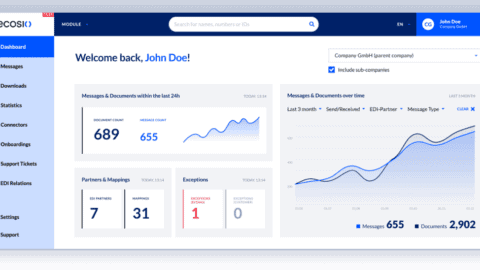With new technologies such as AI and blockchain developing at such a rapid pace, the future of supply chains is a topic of significant concern for many businesses today. Yet while new technologies may be grabbing the headlines, a look at wider shifts in modern B2B relationships suggests that the next decade is more likely to be defined by the adoption of new approaches to older, more embedded technologies. In particular, electronic data interchange (EDI) solutions are changing rapidly, and as automated communication is such a crucial part of modern commerce, supply chain success seems increasingly tied to companies’ EDI and e-invoicing proficiency.
To provide some insight into what the next few years are likely to hold for supply chain businesses, we asked ecosio co-founders and B2B integration experts Philipp Liegl and Marco Zaplatel to give us four key predictions. Here’s what they said…
#1 – Electronic data interchange (EDI) will continue to grow in popularity

Over the past two decades EDI has seen huge change. Thanks to dramatic advances in technology, not only is message exchange automation now possible across many more B2B processes, but crucially it is also now far more accessible. Whereas EDI was once a luxury open only to those businesses with extensive internal resources and technical expertise, today all businesses can experience the benefits of automated document exchange.
This accessibility, combined with other factors, such as the recent introduction of mandatory e-invoicing across much of Europe and the increased desire for supply chain sustainability in the wake of the recent pandemic, means that EDI’s popularity is only likely to grow further in the coming years. This is also echoed by recent research by Gartner, which predicts that a whopping 80% of B2B sales interactions between suppliers and buyers will occur in digital channels by 2025.
#2 – EDI will become increasingly central to business success
Due to factors such as the globalisation of markets, an ever-increasing demand for data visibility across supply chains, and the growing dependence of revenue upon successful data automation, businesses can no longer afford to treat EDI as an afterthought. What’s more, the financial benefits offered by EDI are only set to increase as technology continues to advance and improve the efficiency and transparency of automated data exchange. IDC research, for example, suggests modernised B2B integration could offer businesses a 308% ROI – or more than £3 in benefits per £1 invested!
It’s only logical, therefore, that the future of supply chains will see more and more businesses identify EDI as a critical component of ERP systems (as future-focussed organisations already do).
#3 – EDI will continue to become a “service”
Unfortunately, EDI’s growing popularity doesn’t mean automated document exchange with partners will get easier from a technical perspective. Rather, as businesses look to extend automation across more processes, and different countries introduce different regulations, operating a successful EDI solution will become harder for in-house teams. As a result we should see more and more businesses adopting an EDI as a Service solution as part of a so-called “postmodern” ERP system, in which a core ERP system is extended with tailored cloud-based solutions from independent providers. This way, businesses can enjoy all the benefits of efficient document exchange with none of the hassle and risk. Essentially, EDI is about to transform from a technology for enterprises to a core service for enterprises… a core service, which is yielded by external service providers.
#4 – Solution flexibility and scalability will become a must
Given the rapid pace at which tech is advancing and the volatility of modern supply chains, selecting an EDI solution that can evolve to suit changing needs will be a major concern for IT decision makers over the next few years. We expect to see more caution from buyers regarding potential future functionality changes and an increase in demand for cloud-based, modular solutions, in which updates are implemented on an ongoing basis by the provider and new features are added on a regular basis.
Conclusion
While what exactly the future of supply chains will be may be difficult to predict, what is certain is that cloud-based, EDI as a Service constitutes the only logical long-term option for many businesses. When it comes to key issues such as cost efficiency, sustainability and flexibility, there is simply no alternative.
At ecosio we’re always thinking of the future and pride ourselves of being ahead of the competition both in terms of technology and approach. While the ecosio cloud-based EDI solution (our Integration Hub) and dedicated document and integration engineers ensure you experience streamlined, hassle-free EDI today, our unique, cloud-based approach is designed to support you into the future. However your situation changes, our regularly updated, modular solutions and passionate EDI experts will ensure your solution remains successful. With “Connections That Work” you will experience the full potential and benefits of EDI with minimum effort.
Want to learn more about the future of supply chains?
This article is taken from our white paper Building Connections That Work: The ecosio Approach. To download your free copy today, simply follow this link and enter your details.
For a more detailed breakdown of the future of EDI, you may find our article on this topic interesting, too.


























